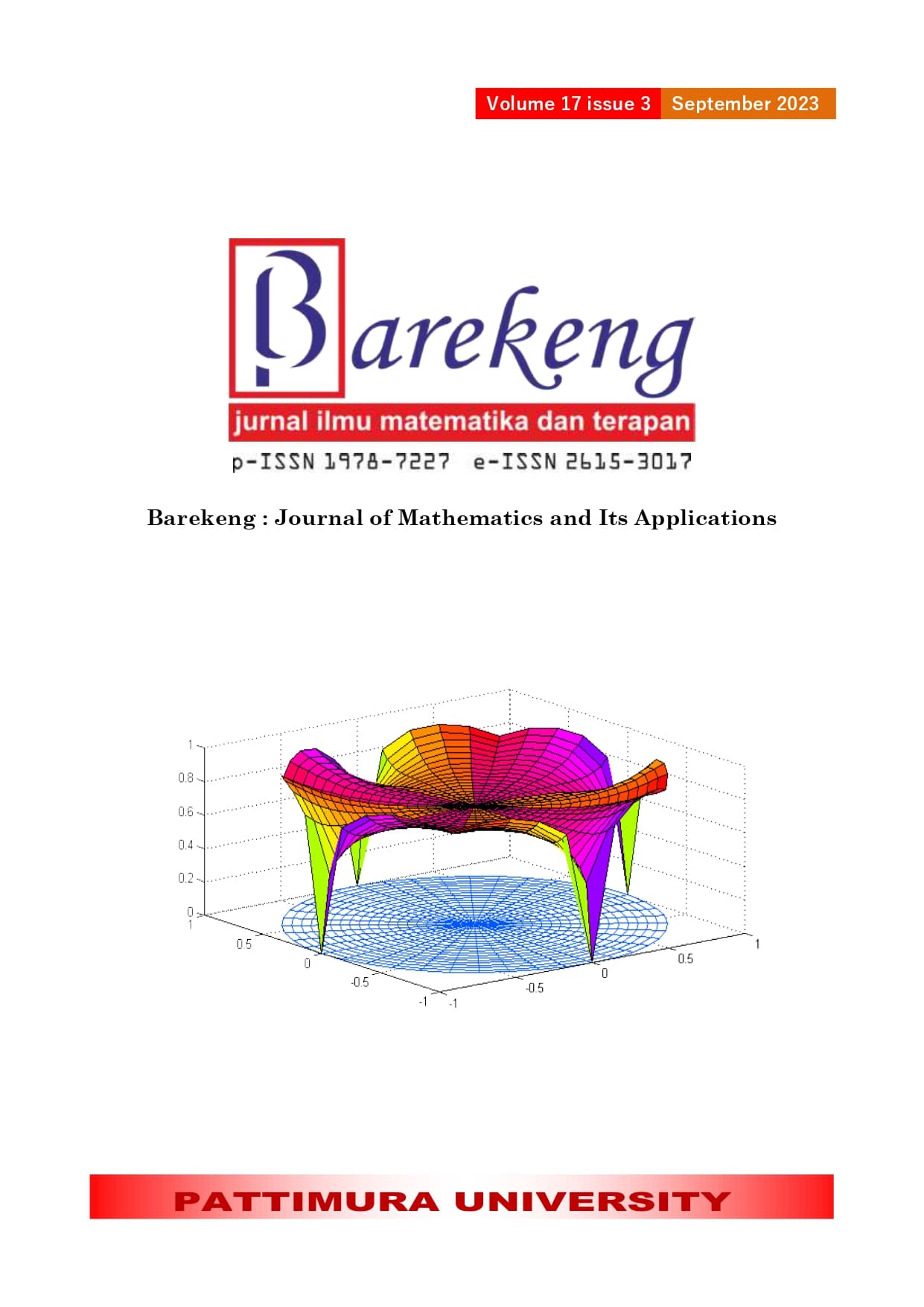CLASSIFICATION OF TODDLER’S NUTRITIONAL STATUS USING THE ROUGH SET ALGORITHM
Abstract
The health and nutrition of children at the age of five are very important aspects in the children’s growth and development. An assessment of the nutritional status of toddlers that is commonly used is anthropometry. This study aims to obtain the decision rules used to classify toddlers into nutritional status groups using the rough set algorithm and determine the level of classification accuracy of the resulting decision rules. The index used in this study is the weight-for-age index. Attributes used in this study were the mother’s education level, mother’s level of knowledge, the status of exclusive breastfeeding, history of illness in the last month, and nutritional status of toddlers. The results of the analysis show that there are 21 decision rules. In this study, the resulting decision rules experience inconsistencies. The selection of decision rules that experience inconsistencies is based on each decision rule’s highest strength value. The rough set algorithm can be used for the classification process with an accuracy rate of 86.36%.
Downloads
References
Y. Asih, “Hubungan pemberian stimulasi perkembangan balita di posyandu,” J. Ilm. Keperawatan Sai Betik, vol. XI, no. 2, pp. 211–215, 2015.
E. Budianita and Novriyanto, “Klasifikasi Status Gizi Balita Berdasarkan Indikator Antropometri Berat Badan Menurut Umur Menggunakan Learning Vector Quantization,” Semin. Nas. Teknol. Informasi, Komun. dan Ind., vol. 7, no. November, pp. 213–220, 2015.
E. Berlina, “Faktor Yang Mempengaruhi Status Gizi Pada Balita Di Posyandu Desa Semen Kecamatan Paron Kabupaten Ngawi,” STIKES Bhakti Husada Mulia Madiun, 2021.
E. N. Candra, I. Cholissodin, and R. C. Wihandika, “Klasifikasi Status Gizi Balita menggunakan Metode Optimasi Random Forest dengan Algoritme Genetika (Studi Kasus: Puskesmas Cakru),” J. Pengemb. Teknol. dan Ilmu Komput., vol. 6, no. 5, pp. 2188–2197, 2022.
F. A. D. Aji Prasetya Wibawa, Muhammad Guntur Aji Purnama, Muhammad Fathony Akbar, “Metode-metode Klasifikasi,” Pros. Semin. Ilmu Komput. dan Teknol. Inf., vol. 3, no. 1, p. 134, 2018.
Z. Qinghua, X. Qin, and W. Guoyin, “A survey on rough set theory and its application,” A Surv. rough set theory its Appl. CAAI Trans. Intell. Technol., vol. 1, no. 4, pp. 323–333, 2016, doi: 10.1016/j.trit.2016.11.001.
A. Amin, S. Anwar, A. Adnan, M. A. Khan, and Z. Iqbal, “Classification of cyber attacks based on rough set theory,” 2015 1st Int. Conf. Anti-Cybercrime, ICACC 2015, pp. 1–6, 2015, doi: 10.1109/Anti-Cybercrime.2015.7351952.
A. Burney and Z. Abbas, “Applications of Rough Sets in Health Sciences and Disease Diagnosis,” Recent Res. Appl. Comput. Sci., pp. 153–161, 2015, doi: 10.1166/jctn.2021.9720.
E. Ramentol, J. Madera, and A. Rodríguez, “Early detection of possible undergraduate drop out using a new method based on probabilistic rough set theory,” in Studies in Fuzziness and Soft Computing, vol. 377, Springer International Publishing, 2019, pp. 211–232.
J. Becker, A. Radomska-Zalas, and P. Ziemba, “Rough set theory in the classification of loan applications,” Procedia Comput. Sci., vol. 176, pp. 3235–3244, 2020, doi: 10.1016/j.procs.2020.09.125.
J. Qu, X. Bai, J. Gu, F. Taghizadeh-Hesary, and J. Lin, “Assessment of rough set theory in relation to risks regarding hydraulic engineering investment decisions,” Mathematics, vol. 8, no. 8, p. 1308, 2020, doi: 10.3390/MATH8081308.
Z. Pawlak, “Rough sets,” Int. J. Comput. Inf. Sci., vol. 11, no. 5, pp. 341–356, 1982, doi: 10.1007/BF01001956.
J. G. Bazan, H. S. Nguyen, S. H. Nguyen, P. Synak, and J. Wróblewski, “Rough Set Algorithms in Classification Problem,” in Rough Set Methods and Applications, L. Polkowski, S. Tsumoto, and T. Y. Lin, Eds. Heidelberg: Physica, 2000, pp. 49–88.
R. Kalaivani, M.V. Suresh, and A. Srinivasan, “Study of Rough Sets Theory and It’s Application Over Various Fields,” J. Appl. Sci. Eng., vol. 3, no. 1, pp. 447-455, 2017.
D. Q. Miao, Y. Zhao, Y. Y. Yao, H. X. Li, and F. F. Xu, “Relative reducts in consistent and inconsistent decision tables of the Pawlak rough set model,” Inf. Sci. (Ny)., vol. 179, no. 24, pp. 4140–4150, 2009, doi: 10.1016/j.ins.2009.08.020.
X. Li, “Attribute Selection Methods in Rough Set Theory,” San Jose State University, 2014.
S. M. Abbas, K. A. Alam, and S. Shamshirband, “A soft-rough set based approach for handling contextual sparsity in context-aware video recommender systems,” Mathematics, vol. 7, no. 8, pp. 1–36, 2019, doi: 10.3390/math7080740.
J. Zhang, X. Zhang, and W. Xu, “Lower Approximation Reduction Based on Discernibility Information Tree in Inconsistent Ordered Decision Information Systems,” Symmetry., vol. 10, no. 7, pp. 1–16, 2018, doi: 10.3390/sym10120696.
A. Skowron and C. Rauszer, “The Discernibility Matrices and Functions in Information Systems,” Intell. Decis. Support, vol. 11, pp. 331–362, 1992, doi: 10.1007/978-94-015-7975-9_21.
S. Chen, Z. Jiang, C. Duan, and X. Dai, X. Mi, “A Decision Analysis Method Based on Rough Set,” Advances in Intelligent Systems Research., vol. 161, pp. 50-56, 2018, doi: 10.2991/tlicsc-18.2018.8
M. Awad and R. Khanna, Efficient Learning Machines: Theories, Concepts, and Applications for Engineers and System Designers. Berkeley: Apress, 2015.
Copyright (c) 2023 Izzati Rahmi, Yana Wulandari, Hazmira Yozza, Mahdhivan Syafwan

This work is licensed under a Creative Commons Attribution-ShareAlike 4.0 International License.
Authors who publish with this Journal agree to the following terms:
- Author retain copyright and grant the journal right of first publication with the work simultaneously licensed under a creative commons attribution license that allow others to share the work within an acknowledgement of the work’s authorship and initial publication of this journal.
- Authors are able to enter into separate, additional contractual arrangement for the non-exclusive distribution of the journal’s published version of the work (e.g. acknowledgement of its initial publication in this journal).
- Authors are permitted and encouraged to post their work online (e.g. in institutional repositories or on their websites) prior to and during the submission process, as it can lead to productive exchanges, as well as earlier and greater citation of published works.






1.gif)



